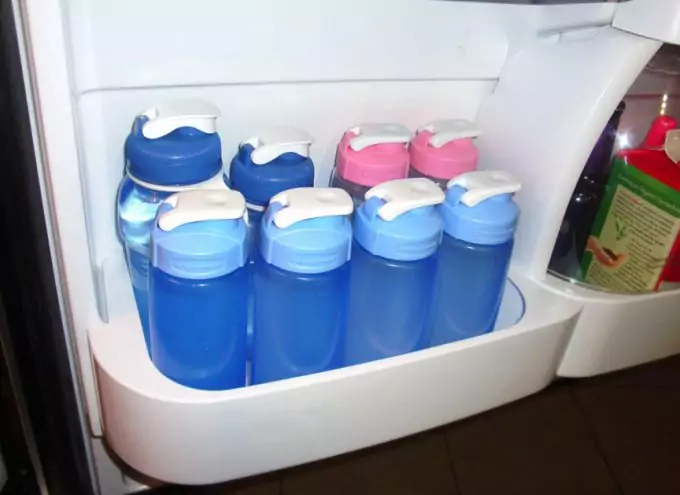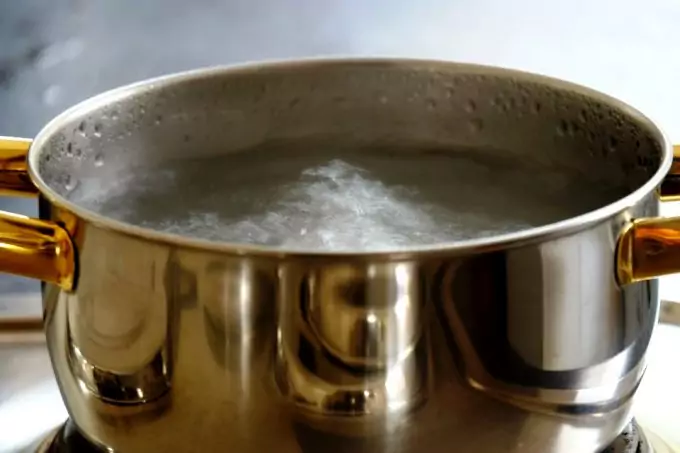Experts agree that humans cannot survive extreme conditions without drinking water for a maximum of three days. The number of exact days varies depending on the condition but one thing is certain, humans cannot live without it; and with the increased number of disasters affecting civilization nowadays, knowing how to store water for a long time is increasingly becoming a survival skill that one should not live without.
[the_ad_placement id=”in-text-1-type-r”]It is not as easy as it sounds; sure you can store water in your fancy water bottles, pitchers and juice gallons, but how long will they last you? Will cleaning the containers be enough to get you through a long period without the contaminants already thriving in them making you sick?

You don’t have to be a chemist to learn and master the art of storing water for a long period; all you need are some instructions and the basic tools necessary to ensure that you will have water to last you for days on end.
How much water should be stored
On average, a person would, and should, drink at least 8 glasses of water per day and this would add up to a total daily water requirement of about half a gallon. This figure does not include water that you would use for cooking and cleaning related implements. If you were to consider this, then the minimum amount of water that you should store for personal use is about a gallon per day.
Personal hygiene can be part of the consideration but in emergencies this should be placed in the back burner and considered for later when everything has settled. Store just enough extra water for you to wash your hands and face and that should be about it.

The only disadvantage about putting your personal hygiene behind everything else is that you will end up stinking with grimy hair and dirt marks like those you see in movies when the actors come out of a devastated area or the ruins of someplace gone.
As a rule of thumb, it’s better to store water that will last you for two weeks and given the one gallon a day minimum, the total amount of water that you should store would be about fourteen gallons of water per person. Going beyond the two weeks is up to you but most government contingency plans ensure that basic services should be up and running after a week, two at the most.
Where to store the water
Before you begin the process of storing water for a long period of time, it is best to know and understand which materials can and will store water without sacrificing the taste and quality. Yes, you can store water using plastic bottles you find in supermarket aisles but the water stored in them changes its taste so much that you can actually tell the difference.

Water stored in such containers for a long period of time tends to taste stale, or worse, disgusting.
Plastic containers for storage
Water containers made of plastic are the top choice for long term storage but you need to be careful in choosing which plastic the containers would be made of. Most plastic containers made for containing food and water has a BPA level indicator at the bottom which usually appears as a number inside a triangle with arrows on the side. These markers indicate the percentage of BPA mixed in with the chemical composition of the plastics. Usually, plastic food containers would have a BPA level rating of 7.

The disadvantage of using low density plastic, like the ones used for bottled water, is that it is porous and any level of heat applied to it will cause the chemicals to be released into the water, contaminating the water you have stored.
For a two-week water storage depot, you can opt to use 5-gallon jugs that are made of dark blue, hard plastic and are classified as food grade. The dark color restricts light and therefore helps limit, and prevent, the growth of algae. You can use empty water bottles that you might have kept or found but remember to clean them thoroughly and water stored in these bottles may need further treating before drinking them.
For storing water for a longer period of time, plastic water barrels are best way to go. These barrels can hold up to 55 gallons and have the same properties as the 5-gallon jugs discussed earlier.
Before you use plastic water containers though, make sure to follow the following steps in preparing them for long term water storage.
- Wash each of the containers thoroughly with tap water and antibacterial dish soap.
- Rinse the containers and ensure that all soap suds are removed. You may need to repeat this step a couple of times for each container just to be sure.
- Once the soap suds have been rinsed off, sanitize each container using a bleach solution that is made of bleach and water (1 tsp bleach = 1 quart of water).
- Swirl the solution about and rinse the plastic containers again.
Glass containers for storage
Glass water containers are available in the market and they are easy to come by. You can use old soda and wine bottles and any other glass container available as long as it is clean and is food grade. Assembled glass containers can be used but with extra caution as the joints can leak after a period of time. They are easy to clean and sterilize and does not have the same chemicals that plastic containers have.

There are a few disadvantages in using glass water containers though. They become heavy when filled with water; they break easily especially when dropped from a height; and you would need to shield it from the light to prevent algae growth. A couple of these can be addressed easily though.
To prevent the glass from breaking and light from filtering in, you can wrap the glass water container in foam or newspaper before placing them inside a wooden crate or a carton box before storing them in a cool, dry and unlit place.
[the_ad_placement id=”in-text-2-type-r”]In order to prepare the glass water container for long term storage, you just need to wash it with soap and water, rinse thoroughly and sterilize it by boiling them in water for about 20 minutes or so before letting it dry with the opening oriented downwards.
Stainless steel containers for storage
Stainless steel water containers are the best option for you if you have the space and the budget for it. These can be old milk containers that can hold 5 gallons or more. Bigger water tanks can also be custom made to hold larger capacities of potable water.

Steel or aluminum water containers are naturally opaque so they do a better job in preventing algae growth and it is more durable than glass and plastic. The disadvantage with this type of water container is that you have to make sure that the chlorine level in the water is low enough that it would not corrode or damage the container itself but other than that, just follow wash the container with soap and water and rinse as usual.
Making each drop last
Now that you know the different materials you can use, it’s time to store water.

Storing water in newly cleaned containers involves a few steps to make sure that the water you will be storing will last for a long time.
- Boil. Fill up a kettle or a water heater and boil the water for about 10-15 minutes before allowing it to cool. This would kill most of the contaminants and chemicals commonly found in tap water. Bacteria and larvae are also eradicated through this method. Read on our article on how boiling purifies water and make it safe to drink.
- Chlorinate. This is optional but you can use chlorine bleach to prevent the growth of micro –organisms. The best ratio is 16 drops of unscented bleach to one gallon of water.
- Seal. Seal the container tightly using the provided caps or using improvised caps that are fit snuggly around the opening. Make sure that the cap has been cleaned and sterilized before putting them on. You can also choose to seal the opening by wrapping it in plastic, rubber or cloth.
- Store. Once the water containers are cleaned, filled and sealed, store them in a cool dry place, preferably without windows and away from kerosene, gasoline and other harmful chemicals as vapors that emanate from them can be absorbed especially if you are using plastic containers. Steel and plastic water containers can be stacked on top of each other to save on space and you need to be careful with the glass ones as they do break easily.
Other than the steps previously discussed, here are some tips that can also be used in storing water:
- Filter – run the water through a filter before boiling, this will remove any large, visible contaminants. For the best water filter available in the market, see our article on the topic to find out more.
- Hose – never use the garden variety of hose as they would have some residual chemicals in their linings.
- Pets – if you have pets, consider their welfare as well. Make sure that you store some water for them too.
- Check – check your stored water every six months to check for impurities and contamination, this would ensure that you will have a constant supply of clean, potable water.
- Yellow Mellow – when checking your stored water, remember that if it’s already yellowish, just let it mellow down a bit by running it through a quick boil. However, anything darker than yellowish should be discarded.
Back up systems
Storing enough water to last you for two weeks or more is a great way of preparing for the worst but disasters, natural or man-made, are unpredictable and even if you have stored water that will last you for a month, chances are it will run out sooner than expected. With this in mind, it is better to have a contingency plan to extend and replenish your water supply.
Water recycling – Any excess water used for cooking and cleaning should be recycled and used for other purposes. You can use recycled water to rinse dirt off dishes, wash your pets and water your garden.
Treat pond water – Worst case scenario is that your stored water would run out and the only source of water is a pond, river, or any other inland body of water. Bodies of fresh water though are hard to find and even if you do find one, chances are it has a high coliform content doubling the risk of acquiring water-borne diseases like diarrhea and gastroenteritis. You can still use these though; you just need to know how to treat them properly. The first thing to do is to filter the water, boil it for an hour or so and let it cool. Use chlorine tablets to eliminate any bacteria and other contaminants. Our article review on the best water purification tablets will help you make a decision on what to use.

Harness the Sun – If you happen to live in a sunny area then you can also use the sun to gather water. Yes, the sun and yes, it is weird. This type of gathering water using the sun is called a solar still. The process is quite simple, you use the heat from the sun to drive evaporation from the air and wet soil and let the vapors condense and cool on a condenser film. The principle behind the solar still replicates the way rain is made and the resulting water is actually way cleaner and more pure than rainwater as condensation removes any impurities like salts and such.
[the_ad_placement id=”in-text-3-type-r”]Kiss the rain or snow – Collecting raindrops for water supply is not really a new thing as humans have been doing it for a long, long time. You just need to position a collecting reservoir near the gutters when it rains and let it fill up. You can treat the water just like the way you would treat water from inland sources, although you would need to wash the reservoir first and keep it covered when not in use.

Back to the roots – Jungle experts have taught us that roots and vines contain safe drinking water that already has electrolytes and other nutrients. This is true but knowing which root can contain root takes some time to learn.
If you don’t have the time and the patience, you can also harness the leaves to collect water using the same principles as the solar still. Get a clear plastic bag and place it over a well leafed branch that receives a generous amount of sunlight. This does take some time though but it does offer another avenue for collecting water.
To learn more about purifying water using primitive and handy methods to survive, read our article on this important topic.






I always keep a roll of tin foil in by BOB; it is practical in collecting and heating water in time of distress. Also, while digesting, the body tends to use more fluids so it’s better to remain hungry than eat when there’s no water to drink!
Water is life, and we all need it, but what is the “expiration date” of water or how long can it last with out going bad?
Hi!
Thank you for the comment. It is a common misconception that water “expires” because of the dates on the water containers but the truth is, you can drink the water even if it’s past the date indicated. Like tin cans, the expiration dates are for the containers not the food contents. The expiration date is the estimated date of when the chemicals used to make the container will leach into the whatever is stored inside. So yes, you can drink or eat the items beyond the expiration date but do know that you are exposing yourself to the chemicals that can be harmful to your health. A rule of thumb for me is to consume it months after the date but not years.
David
well now I finally drink in peace, as long as the glass is half-full.
Thank you for the comment The 5orce. The glass should always be half-full in my opinion.
– David